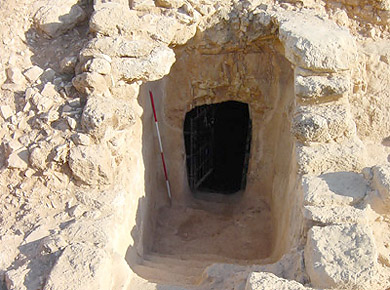
![]()
The Masks of Christ

The recently discovered Cave of John the Baptist near Suba in Israel 
A page from the long-lost Gospel of Thomas 
The death of Simon Magus, according to legend |
'[Picknett and Prince] strike boldly and unreservedly against what they see as the mythos that transformed the historical Jesus into a God... Studying the traditions and tensions that surrounded the early Christians and filtering these through the lens of skepticism, they create a picture that is both challenging and disturbing.' Publishers Weekly 'As balanced as any book on this subject could be, it provides a fascinating read for those interested more in historical fact than dogma… A challenging subject made easy to grasp and make your own mind up about...' Deep London magazine 'By peeling back the layers of "Paularisation" which have camouflaged Jesus and his relationship with John the Baptist, his family, resurrection, and pagan influences in Second Temple Roman times, Picknett and Prince give us a fascinating insight into the reality of earliest Christianity... The authors' treatment of the Dead Sea Scrolls, and the connections of John and Jesus to this secretive sect, adds spice to an already heady mixture of highly informative reading.' Dr Robert Feather, author of The Copper Scroll Decoded and The Secret Initiation of Jesus at Qumran Lynn and Clive have wanted to write The Masks of Christ for many years - and the recent explosion of interest in the historical Jesus and the origins and shaping of the Christian religion presented them with the ideal opportunity. The book's central questions are: who was the real Jesus? How - and more importantly why - did the Church change his message? Drawing on the latest New Testament scholarship and exciting new archaeological finds, such as the Cave of John the Baptist in Israel, claims of discoveries of Jesus' tomb, and long-lost texts such as the Gospel of Judas, the book builds on and develops the major themes of Lynn and Clive's 1997 classic The Templar Revelation. It attempts to identify the historical Jesus, as well as examining the various, hugely conflicting theories about him that have been suggested over the years - the many masks behind which his real self has been hidden. Taking the reader through the latest research into the historical reality behind the New Testament stories, it reveals how they, and the beginnings of the West's major religion, are considerably more complex and mysterious than the Church leads us to believe. It also shows how many of the most cherished ideas about Jesus are now known to be wrong - the result of either misunderstandings, mistranslation or, in many cases, blatant editing and censorship by the first Christians. Lynn and Clive explore a number of challenging questions, such as: Was Jesus married? Was the story of the virgin birth invented to explain the absence of his father? Did he ever actually claim to be the Messiah? Were the claims of an intimate relationship with Mary Magdalene a later invention, or were they truly man and wife, or even just lovers? What was the real relationship with his family, particularly his mother? What was the real significance of the 'cleansing' of the Temple? Why was he condemned and executed? What lies behind the claims of his return from the dead? And how did his movement turned into the most successful religion the world has ever seen? The implications of this radically new picture of the man worshipped as God by millions, and how his mission was transformed - and even distorted - into a religion are truly seismic. One of the book's major themes is an attempt to resolve the long-running, and crucial, debate over the conflicting Jewish and 'pagan' elements in Jesus' teaching and deeds. For example, on one hand he clearly aimed his mission at the Jews and consciously modelled his career on the Jewish expectations of the Messiah, while on the other he used rituals apparently modelled on the Greek and Egyptian mystery cults, such as the communion meal of bread and wine representing his body and blood. And the reconciliation of these apparently irreconcilable elements, Lynn and Clive argue, reveals the authentic man behind the masks. The key lies in the much-misunderstood land of the Samaritans: particularly revealing is a comparison between Jesus and the notorious 'bad Samaritan', the suspiciously reviled heretic Simon Magus, who still has the power to turn much of what we thought we knew about Jesus on its head. But the major theme is the crucial role of John the Baptist and his true relationship with Jesus - which, with not the slightest exaggeration, is the greatest cover-up of the last two thousand years. From the very earliest days, Christian leaders have acted to suppress the facts about this profoundly unsettling issue, even rewriting their own sacred books, and deliberately distorting Jesus' words about John - and they continue to do so to this day. In a sense, they had no choice - because to acknowledge the reality would be to reveal the true source of Jesus' authority, and would completely, and finally, undermine their own religion.
|
